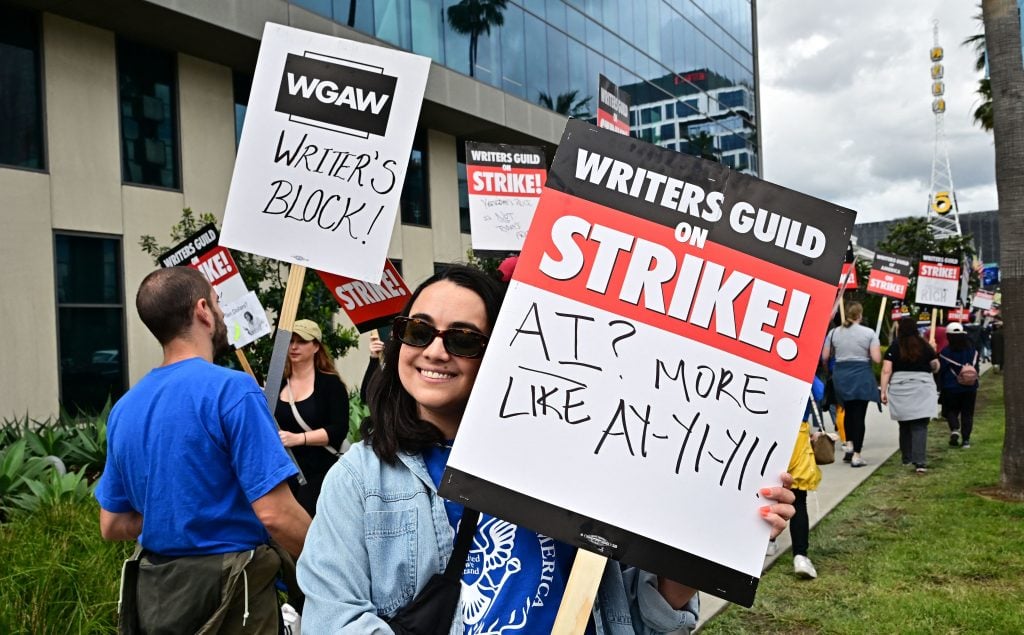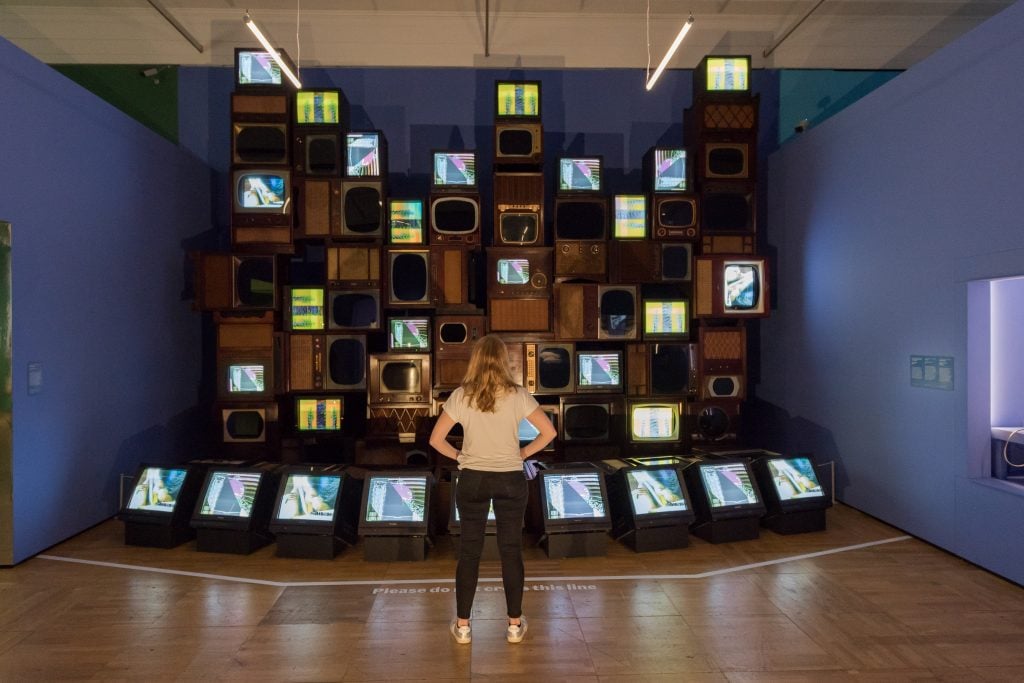The Gray Market
Why Should Artists Care About the Writers’ Strike? Because They Work Under the Same Global Pressures
Our columnist unearths the hidden parallels between the Writers Guild of America’s walkout and the average artist’s plight.

Our columnist unearths the hidden parallels between the Writers Guild of America’s walkout and the average artist’s plight.

Tim Schneider

Every week, Artnet News brings you The Gray Market. The column decodes important stories from the previous week—and offers unparalleled insight into the inner workings of the art industry in the process.
This week, two roads converging…
The Writers Guild of America (WGA), the joint entity comprising the two largest coastal unions of film, television, radio, and online-media scribes, officially went on strike on May 2 after contract negotiations with the Alliance of Motion Picture and Television Producers (AMPTP) failed.
Roughly one week in, the only thing everyone agrees on is that the work stoppage is likely to continue for months. The main reason? They can’t agree on the definition of fair compensation for writers in a business where the fundamentals in 2023 radically differ from those in 2007, the year the WGA last went on strike. But a deeper look at the labor dispute reveals just how much contemporary artists now have in common with entertainment writers—far more than they did 16 years ago.
Before I go further, let me just say up front that I stand with the writers. (Disclosure: Artnet News’s editorial staffers are not a part of any labor union, but my brother is a current WGA member.) I also know full well that the art market and the film and TV business have never been one-to-one equivalents, not least because creatives in the former have been much more resistant to formally organizing than creatives in the latter. Nevertheless, the battle lines in the current WGA strike expose enough parallels between the industries to make that key difference—the absence of a union—all the more important in the decades to come.
Several of the guild’s bargaining priorities arise from an underlying shift that disrupted Hollywood starting in the mid-aughts: the dominant methods of content distribution moved from cable TV broadcasts, theatrical film releases, and DVD sales to streaming, streaming, and more streaming. Obviously, cable TV subscribers still exist, new movies are still debuting in multiplexes around the country, and die-hards are still scooping up Blue-rays of their favorite flicks. But all of these are niche phenomena relative to the early 21st century. One data point says a lot: About half of all YouTube viewership now takes place on TV screens, not mobile devices or computer monitors, per The Information.
For TV writers in particular, the consequences of this transition have run deeper and broader than the average consumer understands. Between roughly 2011 and mid-2022, streaming platforms were encouraged by investors to race to scale faster than their competitors at any cost, profitability be damned. So the streamers started spending billions of dollars to license existing programming and billions more to create new original series and movies available exclusively to their respective subscribers. On the surface, the move by Netflix et al to become producers as well as distributors triggered an avalanche of new offerings for viewers. This eventually culminated in the era of so-called “Peak TV,” a seeming infinitude of new series encompassing a greater-than-ever diversity of concepts, subject matter, and talent.

A staff member looks at Mirage Stage (1986) by Nam June Paik, a video sculpture featuring 33 TV monitors (copyright Nam June Paik Estate) in the exhibition “Hallyu! The Korean Wave” at the V&A on September 21, 2022 in London. (Wiktor Szymanowicz/Future Publishing via Getty Images)
Yet if you thought this new epoch would mean orders-of-magnitude more jobs for more writers, you are mistaken. The caveat was that, on average, seasons of these new series tended to be significantly shorter than series made for broadcast TV, partly because the streamers often spent big to build their new series around movie stars unwilling to commit to shoots as long as, say, the cast of Friends did. Jonathan Handel of Puck has the data:
The economics of Peak TV are tricky. During 2011-2015, the number of series grew by about 50 percent, the number of writers working in TV grew about 20 percent, but the aggregate number of scripted episodes produced grew only by about 7 percent thanks to the decline in average season length—a stunning drop from 18.8 episodes per season to 13.2.
OK, so, somewhat more writers being paid to create only slightly more TV in the aggregate. Maybe not great, but not bad, right?
Unfortunately, it’s not that simple. First, shorter seasons mean shorter-term employment, reducing stability in the job of writing for TV. Writers would still come out ahead in this tradeoff if they were also making significantly more money for their work. But it seems they’re actually making far less. One villain in this shift has become the “mini-room,” a moniker for a minimal collection of writers paid a reduced rate for two to three months to develop and partially script a series that may never be greenlit. Another is the streamers’ ironclad commitment to maintaining exclusive rights to their original programming.
Both phenomena lead to streaming TV’s elimination of residuals, a type of royalty that used to reward talent of multiple types for working on shows that went on to become hits. Brooks Barnes and John Koblin of the New York Times explained it this way:
Before streaming, writers and directors (and other creative contributors, including actors) could receive residual payments whenever a show was licensed, whether that was for syndication, an international deal, or DVD sales. In the streaming era, as global services like Netflix and Amazon have been reluctant to license their series, those distribution arms have been cut off.
It’s hard to overstate how drastically the disappearance of residuals has upended the economics of TV. Before streaming, the so-called “success metric” built into residuals was arguably the strongest incentive for writers, directors, and actors to strive for greatness in the medium (as well as weather the hard times when work dried up). Without residuals, however, working on one season of a smash hit has become financially indistinguishable from working on the one and only season of a complete flop; this, despite the fact that hits have become even more lucrative for streamers than they were for networks in the appointment-viewing era of television. Here’s Handel again:
For streamers, a hit brings new subscribers and reduces churn. For a company like Disney, a blockbuster can be monetized in merchandise and even become a theme park ride. For Amazon, popular offerings sell shoes, books and everything else. And for Apple, quality programming burnishes the brand and helps drive sales of iPhones and other products. On the whole, these are all profitable companies that benefit greatly from the content produced by guild members.
To summarize, then, the rise of streaming has created many more new shows while employing modestly more writers in less stable jobs that tend to pay far less on average if their work produces something that audiences love, even as their success funnels significantly more money to streamers—often by juicing complementary revenue streams whose exact financial relationship to the hit TV shows themselves can be impossible to quantify for the talent behind those shows. The upshot is that writing for TV—which was long considered to be as close as a Hollywood scribe could come to a dependable, middle-class job—has become a significantly more precarious proposition on the whole than it was less than a generation ago.
True, this new economy has been kind to a short list of superstar showrunners (see: Ryan Murphy and Shonda Rhimes). But it’s been even more of a boon for the chief executives sitting atop the streamers; recent payouts for Netflix co-CEO Ted Sarandos and recently returned Disney CEO Bob Iger came in at $50 million and $27 million, respectively, even as their companies’ share prices declined.

“Eva Papamargariti: Precarious Inhabitants” installation view. Courtesy of TRANSFER.
There has been no such distribution revolution in the art market since the mid-aughts. To make a living as an artist in 2023, the main job in most cases is still to sell unique or limited-edition pieces to a niche audience of wealthy individuals. There is still little expectation of resale royalties (the art world’s version of residuals), meaning most artists still only get paid when their work is sold the first time—no matter how much higher prices might jump in the secondary market later on.
This is not to say that the business as a whole has stagnated; it’s just that the most meaningful recent evolutions really only apply to a rarefied subset of artists. Luxury brands are clamoring to license and merchandise the work of dead greats and living superstars, not recent MFA grads and mid-career talent. Selling directly to collectors through Instagram or online platforms is an option for everyone in theory but only a legitimate revenue stream in practice for a small handful of artists. Even then, the novel sales channel changes nothing about the underlying model of “make something, sell it to one client, repeat.” The promise that rank-and-file artists could earn serious resale royalties on the NFT market has largely turned out to be a mirage, partly because this new medium has fostered just as much of a star system as the off-chain one.
The irony here is thick and distressing. On one side, technology has mutated the primary business model of scripting for TV for every writer at every level of experience since the mid-2000s. On the other side, the primary business model for making contemporary art has barely budged over the same 16-ish years. And yet, the net effect on both categories of creators has been pretty much the same: more and more of the middle class of the talent pool has gotten carved away, while more and more of the spoils have been captured by an elite constellation of stars.
How can both of these things be true at the same time? Why has a class of creators in an industry genuinely disrupted by technological change been suffering in the same way as its counterpart in another industry whose inner workings have been all but fossilized in amber for decades?
The sci-fi writer Ted Chiang proposed in a 2021 interview that most of our fears about technology are actually fears about how capitalism will use technology against us. To me, this idea is the missing link connecting the plight of TV writers and the plight of most working artists. Since the writers are under pressure after streaming destabilized the old TV distribution mechanisms, and the artists are under remarkably similar pressure despite the fact that nothing much at all has changed about their distribution structure, one sensible explanation would be that streaming isn’t the real problem. Some other force is responsible.
While it’s almost undoubtedly an oversimplification to pin the blame on any one factor, I also think that the incentives of globalization explain an awful lot about why TV writers and contemporary artists are being squeezed in such a similar way. More international trade, freer international travel, and the proliferation of shared online culture, have laid the groundwork for ambitious corporations and individuals to reap bigger rewards than ever, scaling up to clinch worldwide success, while necessarily crowding out other would-be players. The allure for Amazon, Apple, Disney, and Netflix is identical to the allure for top auction houses, mega-galleries, and grade-A art fairs: the opportunity to convert and retain more customers in more places than ever before—and generate profits that would have been unimaginable a few decades before.

Yinka Shonibare CBE, The World Reimagined. Photo: courtesy the World Reimagined.
The global distributors’ job is easier in one sense because many consumers in vastly different places now know about and want many of the same things, thanks to internet buzz. Just like Netflix’s biggest-ever global hit to date has been Squid Game, a Korean series, art dealers can now sell Avery Singer or Gerhard Richter just as effectively to collectors in Hong Kong, Mexico City, or Paris as to collectors in New York. Regional preferences certainly still exist, but global taste is very much a real thing (though seldom an exciting one).
At the same time, the surest way for the distributors to maximize their profits in this new world order is to richly reward known-quantity star talent (whether writers or artists) while driving the hardest possible bargain with the creators responsible for anything less proven. And as the winners-take-all paradigm has intensified, it has become more and more apparent that, behind closed doors, the distributors see more and more of their offerings as replaceable, if not disposable, from the very outset. You can’t enjoy the glow of discovering the next supernova if you don’t manage to keep the galleries and the streaming libraries filled with something in the meantime.
It’s no wonder that some of the WGA’s headline demands mirror some of the concerns from working artists inside and outside the gallery system. The list includes protections against being paid less (or phased out entirely) due to the prospect of A.I. production, as well as requests for greater transparency about distributors’ operations. Similar to how few dealers tell their artists which collectors are buying their work, the streamers have been notoriously secretive about viewership figures and other engagement data for their different shows and movies. And as the art world knows all too well, opacity is opportunity (for middle-men).
These are the types of things creatives have to fight for when the other side believes it can find an easy substitute for their labor. It also explains why contemporary artists, art workers, and art enthusiasts should support the WGA strike. The entertainment world and the art world will always be different in a whole host of ways. But both would grind to a halt without the talent of living people who deserve to be treated and compensated as such, no matter what medium they’ve chosen.
That’s all for this week. ‘Til next time, remember: every technology is agnostic until you aim it toward a goal.